Tisza Investigation
The investigation of the Tisza river was an international expedition carried out by the German Laboratory ship, ARGUS and under the supervision of the ICPDR. The program directly followed the Joint Danube Survey 2001.
The survey was a follow-up activity to the serious cyanide and heavy metal pollution incidents happened in February and March 2000 on the Szamos and Tisza rivers. One of the objectives of the survey was to detect the present environmental situation on the Tisza and its main tributaries one and a half year after the incidents.
The survey was financially supported by the EU and Germany with further contribution of the governments situated in the Tisza basin: Romania, Slovakia, Yugoslavia and Hungary. The logistical organization was provided by the ICPDR Secretariat . The main contracted Institute of the investigation of the Tisza was the Water Resources Research Center Plc. (VITUKI Rt.). Budapest, Hungary.
The sampling mission was carried out between 28 September and 10 October 2001. The samples were analyzed by the Hydrometeorological Institute, Belgrade, by VUVH, Bratislava, and by VITUKI, Budapest.
Based on the investigation no evidence of cyanide or heavy metal pollution was detectable on the Tisza river in autumn 2001.
What where the main findings?
- No elevated concentrations of nutrients were found in the Tisza itself, but in some tributaries.
- The heavy metals showed a characteristic longitudinal profile along the Tisza: moderate and low values in the upper and middle section and significant increase downstream of the Maros confluence.
- High values of cadmium were measured in suspended solids, sediments and mussels. Lead and copper exceeded the limit values in sediments. Elevated mercury concentrations were detected in suspended solids.
- Diatoms (Bacillariophyceae), green algae (Chlorococcales) and Euglenophyceae were the most dominating taxa

Joint Danube Survey: Investigation of the Tisza River and its tributaries Final Report, May 2002
Disclaimer
The information contained in the ICPDR website is intended to enhance public access to information about the ICPDR and the Danube River. The information is correct to the best of the knowledge of the ICPDR Secretariat. If errors are brought to our attention we will try to correct them.
The ICPDR, expert group members, nor other parties involved in preparation of information contained on this website cannot, however, be held responsible for the correctness and validity of the data and information provided, nor accept responsibility or liability for damages or losses arising directly or indirectly from the use of the information conveyed therein.
Only those documents clearly marked ICPDR documents reflect the position of the ICPDR.
Any links to other websites are provided for your convenience only. The ICPDR does not accept any responsibility for the accuracy, availability, or appropriateness to the user's purposes, of any information or services on any other website.
When using the information and material provided on this website, credit should be given to the ICPDR.

